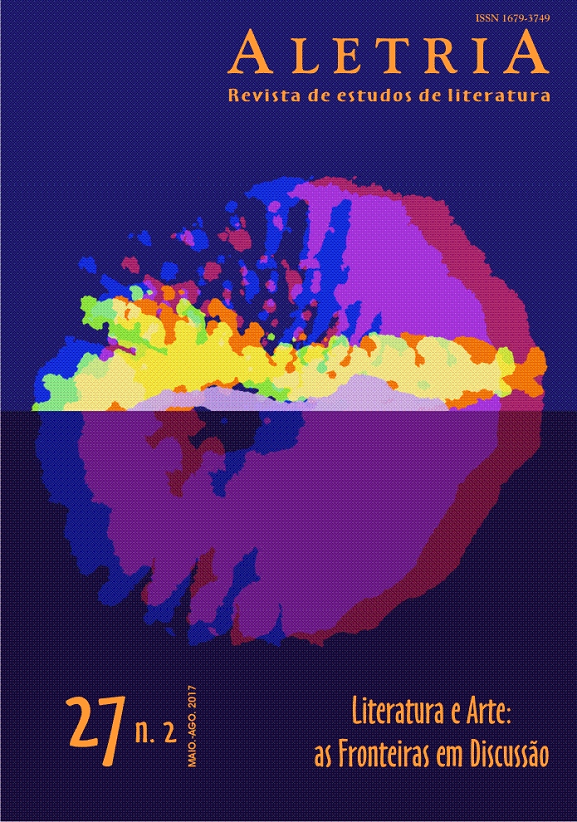Écfrase arquitetônica: um modelo interpretativo
DOI:
https://doi.org/10.17851/2317-2096.27.2.241-260Palavras-chave:
Carmen Oliveira, Michael Sledge, Elizabeth Bishop, Lota Macedo Soares, literatura, arquitetura, écfrase arquitetônicaResumo
A écfrase é um dos possíveis procedimentos midiáticos que trata do cruzar de fronteiras entre a literatura e a arquitetura. O objetivo deste ensaio é apresentar um modelo interpretativo para a tipologia écfrase arquitetônica. Tal modelo será ilustrado pelas biografias romanceadas inspiradas na vida e obra da poeta Elizabeth Bishop e da arquiteta autodidata Lota Macedo Soares, intituladas Flores raras e banalíssimas: a história de Lota de Macedo Soares e Elizabeth Bishop (1995), de Carmen Oliveira, e A arte de perder (2011), de Michael Sledge.
Downloads
Referências
ALBERTI, Leon Battista. Da pintura. Tradução de Antônio da Silveira Mendonça. Campinas: Editora Unicamp, 1999.
ARNHEIM, Rudolf. A dinâmica da forma arquitetônica. Lisboa: Presença, 1988.
AUSLANDER, Philip. Theory for Performance Studies. New York: Routledge, 2008.
BELTING, Hans. Florence and Baghdad: Renaissance Art and Arab Science. Translated by Deborah Lucas Schneider. Cambridge: The Belknap Press of Harvard University Press, 2011.
BISHOP, Elizabeth. Song for a Rainy Season. The New Yorker, New York, p. 40, 8 Oct. 1960.
CLÜVER, Claus. Ekphrasis and Adaptation. In: LEITCH, Thomas (Ed.). The Oxford Handbook of Adaptation Studies. New York: Oxford University Press, 2016. p. 459-477.
CLÜVER, Claus. Ekphrasis Reconsidered: on Verbal Representations of Non-Verbal Texts. In: LAGERROTH, Ulla-Britta; LUND, Hans; HEDLING Erik (Ed.). Interart Poetics: Essays on the Interrelations between the Arts and Media. Amsterdam; Atlanta: Rodopi, 1997. p. 19-33.
COLOMINA, Beatriz (Ed.). Architectureproduction. New York: Princeton Architectural Press, 1988.
ELKINS, James. The Poetics of Perspective. Ithaca: Cornell University Press, 1994.
ELLESTRÖM, Lars. Media Borders, Multimodality and Intermediality. New York: Palgrave Macmillan, 2010.
ELLESTRÖM, Lars. Media Transformation: the Transfer of Media Characteristics among Media. Houndmills: Palgrave Macmillan, 2014.
FLUDERNIK, Monika. Description and Perspective: the Representation of Interiors. Style, v. 48, n. 4, p. 461-478, Winter 2014.
FÜHRER, Heidrun; BANASZKIEWICZ, Bernadette. The Trajectory of Ancient Ekphrasis. In: JEDLICKOVA, Alice (Ed.). On Description. Prague: Akropolis, 2014. p. 45-75.
GIBSON, James Jerome. The Ecological Approach to Visual Perception. London: Lawrence Erlbaum Associates, 1986.
GLASER, Stephanie A. Figures of Space, Figures of Time: Gothic Architecture, Enaergeia, and Periegesis. In: FÜHRER, Heidrun (Ed.). Making the Absent Present: Challenging Contemporary Concepts of Ekphrasis. Lund: Intermedia Studies Press, 2017. In press.
HAMON, Philippe. Expositions: Literature and Architecture in Nineteenth-Century France. Translated by Katia Sainson-Frank and Lisa Maguire. Berkerley: University of California Press, 1992.
HARRIES, Karsten. The Ethical Function of Architecture. Cambridge, MA: The MIT Press, 1997.
HEFFERNAN, James A. W. Ekphrasis and Representation. New Literary History, n. 22, p. 297-316, 1991.
HEFFERNAN, James A. W. Museum of words: the poetics of ekphrasis from homer to ashbery. Chicago: University of Chicago Press, 1993.
LOUVEL, Liliane. A descrição “pictural”: por uma poética do iconotexto. Tradução de Luiz Cláudio Vieira de Oliveira. In: ARBEX, Márcia (Org.). Poéticas do visível: ensaios sobre a escrita e a imagem. Belo Horizonte: FALE/UFMG, 2006. p. 191-220.
LOUVEL, Liliane. Le tiers pictural: pour une critique intermédiale. Rennes: Presses Universitaires de Rennes, 2010. DOI: https://doi.org/10.4000/books.pur.41005.
LUND, Hans. Text as Picture: Studies in the Literary Transformation of Pictures. Translated by Kacke Götrick. Lewiston; Queenston; Lampter: The Edwin Mellen Press, 1992.
MERLEAU-PONTY, Maurice. Phénoménologie de la perception. Paris: Gallimard, 1945.
NORBERG-SCHULZ, Christian. Genius Loci: Towards a Phenomenology of Architecture. New York: Rizzoli, 1980.
OLIVEIRA, Carmen. Flores raras e banalíssimas: a história de Lota de Macedo Soares e Elizabeth Bishop. Rio de Janeiro: Rocco, 1995.
RASMUSSEN, Steen E. Arquitetura vivenciada. 2. ed. Tradução de Álvaro Cabral. São Paulo: Martins Fontes, 2002.
RASMUSSEN, Steen E. Understanding Architecture. Cambridge, MA: The MIT Press, 1957.
ROBILLARD, Valerie. In Pursuit of Ekphrasis (an Intertextual Approach). In: ROBILLARD, Valerie; JONGENEEL, Els (Ed.). Pictures into Words: Theoretical and Descriptive Approaches to Ekphrasis. Amsterdam: VU University Press, 1998. p. 53-72.
SLEDGE, Michael. A arte de perder. Tradução de Elisa Nazarian. São Paulo: Leya, 2011.
SLEDGE, Michael. The More I Owe You. Berkeley: Counterpoint, 2010.
VIEIRA, Miriam de Paiva. Écfrase: de recurso retórico na antiguidade a fenômeno midiático na contemporaneidade. Todas as Letras, São Paulo, v. 19, n. 1, p. 45-57, 2017. Disponível em: http://editorarevistas.mackenzie.br/ index.php/tl/article/view/9955/6384.
WEBB, Ruth. Ekphrasis, Imagination and Persuasion in Ancient Rhetorical Theory and Practice. Surrey: Ashgate, 2009.
Downloads
Arquivos adicionais
Publicado
Edição
Seção
Licença
Copyright (c) 2017 Miriam de Paiva Vieira (Autor)

Este trabalho está licenciado sob uma licença Creative Commons Attribution 4.0 International License.
Autores que publicam nesta revista concordam com os seguintes termos:Autores mantém os direitos autorais e concedem à revista o direito de primeira publicação, com o trabalho simultaneamente licenciado sob a Licença Creative Commons Attribution que permite o compartilhamento do trabalho com reconhecimento da autoria e publicação inicial nesta revista.Autores têm autorização para assumir contratos adicionais separadamente, para distribuição não-exclusiva da versão do trabalho publicada nesta revista (ex.: publicar em repositório institucional ou como capítulo de livro), com reconhecimento de autoria e publicação inicial nesta revista.Autores têm permissão e são estimulados a publicar e distribuir seu trabalho online (ex.: em repositórios institucionais ou na sua página pessoal) a qualquer ponto antes ou durante o processo editorial, já que isso pode gerar alterações produtivas, bem como aumentar o impacto e a citação do trabalho publicado (Veja The Effect of Open Access).














